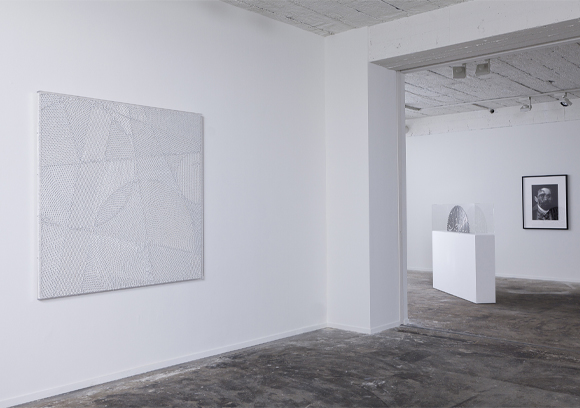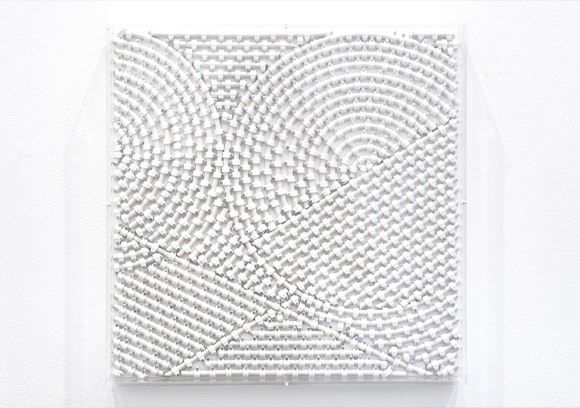| |
|
26.
 | Intersections 07
| Intersections 07 |
| |

'' The spaces defined by this series of compositions are created from the collision of distinct elements, curves and lines, which can cross or be contiguous, assemble into various geometric shapes, create certain spaces and contain others. ''
Studio Fatmi, April 2017

Intersections 01
Exhibition view from Walking on the light, CCC, 2014, Tours.

Intersections 05
Exhibition view from Kissing Circles, Shoshana Wayne, 2012, Santa Monica.
|
|
2011, coaxial antenna cable, staples on plywood, 40 x 40 x 5 cm.
Courtesy of the artist and Ceysson & Bénétière, Paris.
|
|
|
|
Intersections se présente comme une série de compositions à la fois rigoureuses et esthétiques, où chaque format carré aux dimensions identiques et de couleur blanche donne à voir une variété de formes géométriques imbriquées. Des câbles coaxiaux à gaine blanche - matériau employé par Mounir Fatmi depuis ses débuts et observable dans nombre de ses œuvres - sont rassemblés en lignes et en courbes, puis fixés aux panneaux de bois blancs au moyen d’attaches, où ils forment des cercles et des lignes s'entrecroisant.
La série des œuvres présentées peut se lire comme l'exploration artistique d'une notion géométrique. Le spectateur est invité à parcourir une suite de compositions qui apparaissent comme autant d'éléments d'une cartographie ou du quadrillage rigoureux d'un territoire défini par les croisements et rencontres qui s'y produisent. L'œuvre s'inscrit dans une réflexion menée de longue date par Mounir Fatmi sur les mathématiques, la géométrie et la forme, où les influences de Pollock et Malévitch sont perceptibles, notamment dans l'utilisation du dripping ou le recours à l'abstraction géométrique qu'on retrouve dans des réalisations tels que "Cercles", "La Mort de la ligne droite" ou "Kissing circles".
Les espaces définis par la série des compositions se constituent de la rencontre d'éléments distincts, courbes et lignes, qui ont la possibilité de s'entrecroiser ou d'être contigus l'un à l'autre, de s'assembler en formes géométriques diverses, de créer des espaces ou d'en limiter d'autres. L'œuvre examine ainsi les origines de l'intersection, sa nature ou son déroulement et enfin ses conséquences, à savoir la constitution d'espaces et de territoires à géométrie variable, où la multiplication des croisements et des intersections interdit toute identification claire et définitive d'un quelconque centre et empêche le spectateur de poser son regard sur un point d'équilibre sûr, tendant au contraire à induire chez ce dernier un malaise visuel persistant.
La séduction esthétique exercée par les motifs géométriques prépare finalement à une méditation scopique et à une réflexion sur la forme. Un peu à la manière dont certaines équations mathématiques prévoient l'existence de phénomènes physiques bien avant leur découverte et leur observation directe, Intersections invite à explorer le réel et sa géographie à partir de propositions purement géométriques.
Studio Fatmi, Avril 2017.
|
|
Intersections is comprised of a series of compositions that are both rigorous and esthetic, in which uniformly white squares with identical dimensions present a variety of intertwined geometric shapes. White-sheathed coaxial cables – a material used by Mounir Fatmi from his beginnings and found in many of his works – are grouped together to form lines and curves and fixed on white wood panels with tacks, on which they form circles and crisscrossing lines.
This series of works can be interpreted as the artistic exploration of a geometric notion. The viewer is invited to walk through a succession of compositions that reveal themselves as elements in a map or the rigorous quartering of a territory defined by the crossings and encounters that take place within it. The work is part of a long-standing reflection by Mounir Fatmi on mathematics, geometry and shape, where the influence of Pollock and Malevich can be perceived, in particular with regards to the use of dripping or geometric abstraction, elements that can also be found in works such as “Circles”, “The Death of the Straight Line” and “Kissing Circles”. ?
The spaces defined by this series of compositions are created from the collision of distinct elements, curves and lines, which can cross or be contiguous, assemble into various geometric shapes, create certain spaces and contain others. In this way, the work examines the origins of the intersection, its nature, how it rolls out and finally its consequences, namely the creation of spaces and territories with variable geometries, where the multiplication of crossings and intersections forbids any clear and definitive identification of a central point and prevents the viewer from resting his gaze on a reliable pivotal point, creating instead a persistent feeling of visual malaise.
Finally, the esthetic seductiveness of the geometric motifs prepares the viewer for a scopic meditation and a reflection on the concept of shape. Similarly to the way certain mathematical equations predict the existence of physical phenomena long before they are discovered and observed directly, Intersections is an invitation to explore the real and its geography from purely geometric propositions.???
Studio Fatmi, April 2017.
|
|
|
|